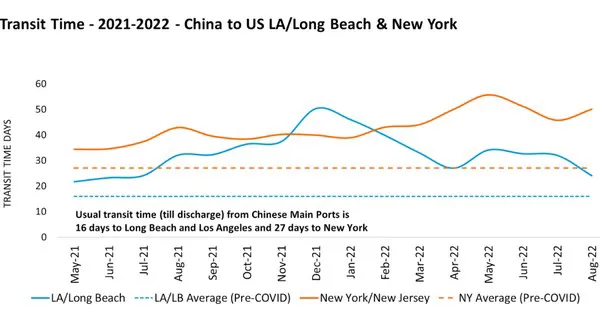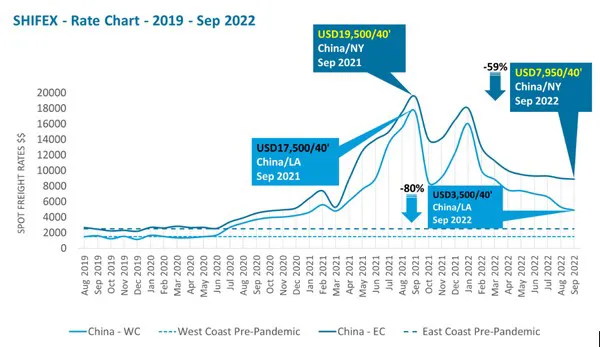SHIFEX, a forwarder-driven container spot freight rate index, recorded the lowest freight rate in 24 months between Shanghai and Los Angeles. The index shows a rate of $3,500/40’--a drop of 80 percent Y-O-Y.
While the decline in rates has been slower between China and New York/New Jersey, the rates still tumbled from a high of $19,600 in September 2021 to $7,950 in September 2022--a 59 percent drop Y-O-Y.
“Tightening monetary policy, a shift in consumer spending, bloated inventories in the U.S. and growing geopolitical tensions between the U.S. and China continue to play a role in the movement of rates,” said Shabsie Levy, CEO and founder of Shifl.

SHIFEX points to a quickening rate of decline in the spot freight market. September marked the eighth month of continuous drop in freight rates between Shanghai and LA/Long Beach, which was the third biggest M-o-M drop (34 percent) since October 2021.
As spot rates on the trade between the world’s two largest economies continue tumbling, shippers are turning up the heat on carriers to renegotiate long-term, fixed contract rates.
While lines like Hapag Lloyd are standing firm on their contract rates, lines like Yang Ming Line are confirming that they have received multiple requests from shippers to renegotiate contract rates and that they are prepared to listen to their customers.
With fewer congestion issues to deal with in Chinese and U.S. ports, carriers were able to cut transit times on the principal lane between China and Los Angeles/Long Beach by 25 percent in August, the biggest improvement this year.

Transit times reached 24 days compared to 32 days in July, bringing them back to levels last seen in July 2021.
Difficulties continue to be felt on the all-water route between Chinese ports and New York, where transit times were up again from 46 days in July to 50 days in August.
Both routes are still above historic levels but West Coast transit times are inching closer to pre-pandemic levels of 16 days.
The build-up of empty containers being repositioned in the U.S. continues, but shippers and carriers are working to keep them from building up at ports.
Average gate out times in Los Angeles/Long Beach stayed steady at five days for the third consecutive month, while the number was four days for the third consecutive month in New York/New Jersey.
So far the port of New York/New Jersey has yet to implement its container imbalance fee in a bid to reduce congestion at the port, opting not to impose the new $100/day congestion fee as originally proposed on September 1.
 For more information:
For more information:
Charlie Pesti
Shifl
[email protected]
https://shifl.com










